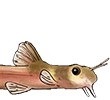Geerinckx, T, J de Poorter & D Adriaens, 2007. Morphology and development of teeth and epidermal brushes in loricariid catfishes. Journal of Morphology 268: 805–814.
Abstract
Loricariidae or suckermouth armored catfishes are one of several aquatic taxa feeding on epilithic and epiphytic algae. Their upper and lower jaws bear exquisitely curved teeth, which usually are asymmetrically bicuspid. The enlarged lower lip carries papillae with keratinous unicellular epidermal brushes or unculi. Teeth, and probably unculi too, assist in scraping food off substrates. Their morphology, growth, and replacement is examined and compared among several loricariid species, using cleared and stained specimens, serial sections, and SEM. Apart from the general tooth form and crown shape, the anterior layer of soft tissue on the lower shaft region, present in several species, appears to be a specialization for enhancing the mobility of individual teeth when scraping on uneven surfaces. During early ontogeny, a transition from simple conical to mature tooth occurs. The first unculi appear together with the first teeth carrying a bicuspid crown, 2 days after the first exogenous feeding, but synchronous with the complete resorption of the yolk sac.
Teeth and epidermal brushes in loricariid catfishes
- Silurus
- Posts: 12420
- Joined: 31 Dec 2002, 11:35
- I've donated: $12.00!
- My articles: 55
- My images: 893
- My catfish: 1
- My cats species list: 90 (i:1, k:0)
- Spotted: 424
- Location 1: Singapore
- Location 2: Moderator Emeritus





